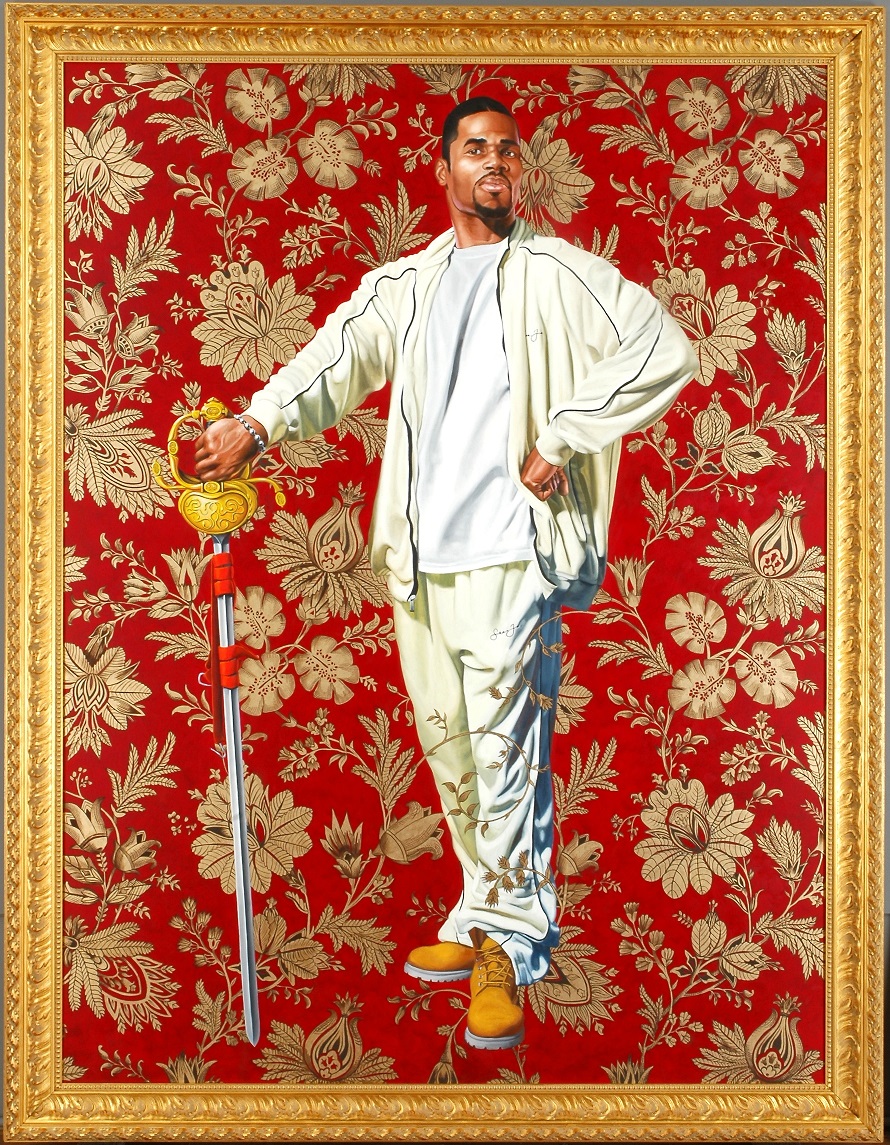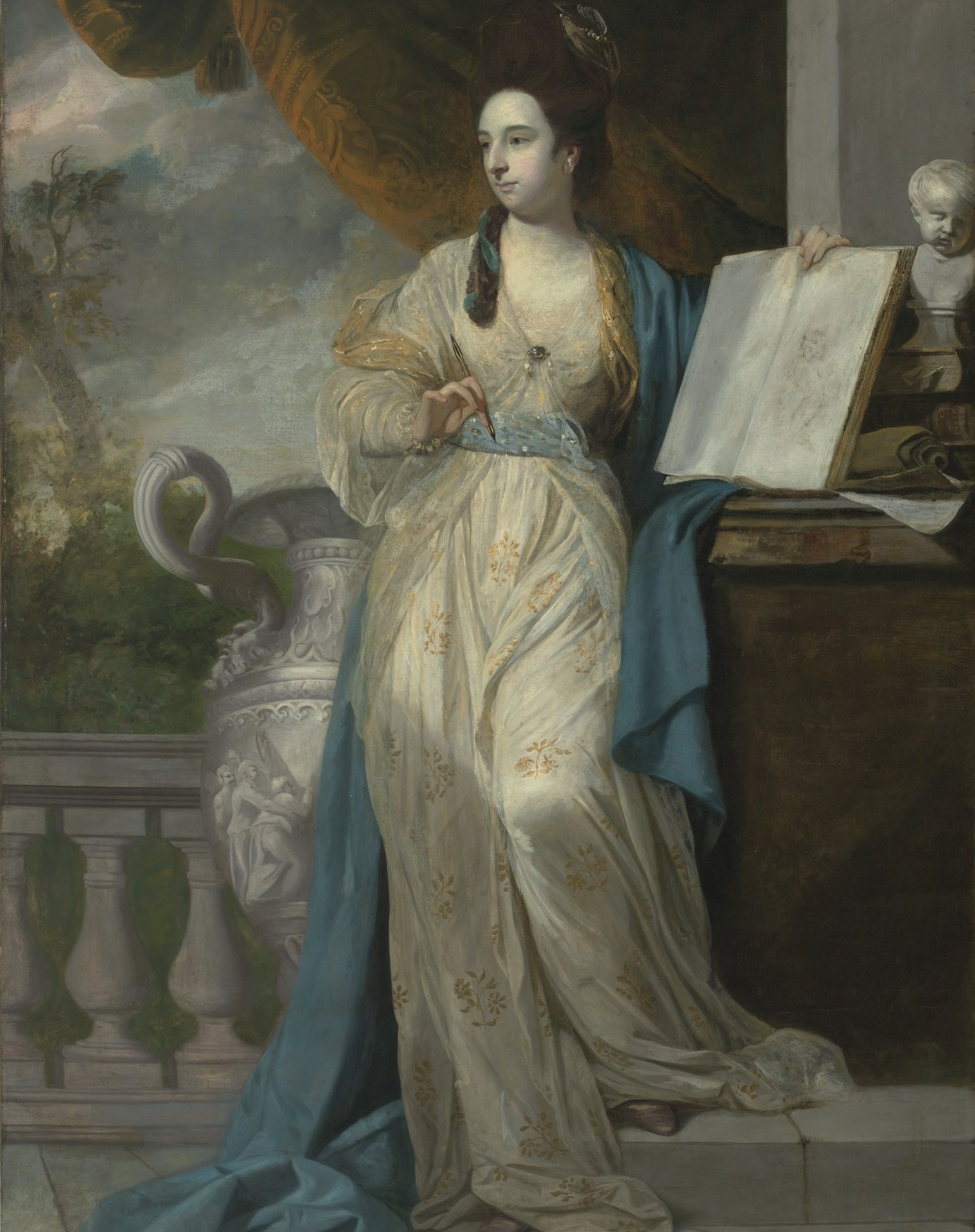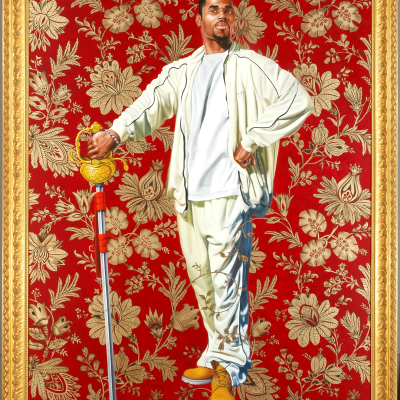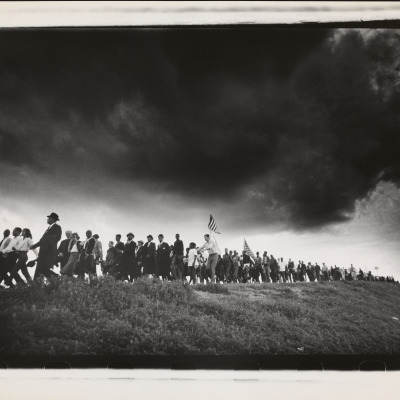Teacher Modification: Use these two images as a model before you put students into pairs. Use the Explore and Create- Teacher Version handout to share an example of the intended goal for the chart and dialogue.
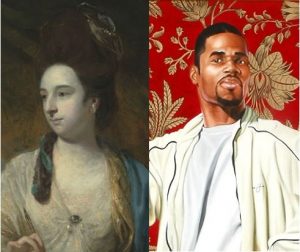
Unlikely Pairings: Conversations through Art
Use this resource to help students explore the human experience across time and place, give voice to diverse perspectives found in art, and collaboratively reimagine a museum that presents a new story centered around our shared human interactions.
Introduction
Objective
The goal of this resource is for students to analyze art in an insightful, creative manner by identifying multiple perspectives and drawing connections across different times and places. These comparative skills will provide a basis for student discovery into how art connects human experiences and different perspectives.
We encourage you to adapt these strategies and select works that make sense for your curriculum and classroom. While this lesson incorporates a few specific works from VMFA’s collection, the strategies modeled can be used for any work of art.
Inspiration
Most art museums organize objects into collections by culture or time period. While this organization helps to provide context to the works of art, it also sets up barriers between works in different collections. The activities in this lesson ask students to question traditional methods of viewing art within separate and distinct narratives in favor of creating connections and prompting dialogue between works of art. An example of bridging collections to create a dialogue is the installation of Kehinde Wiley’s painting Willem van Heythuysen installed next to Joshua Reynold’s painting, Maria, Lady Broughton. These works are from different collections, time periods, and places and the figures in the works would perhaps have little in common—but they are both portraits of power and grandeur. Hung side by side, they ask the viewer to consider questions of power, identity, race, and gender. This lesson creates an opportunity for students to bridge barriers, identify diverse perspectives, and make connections between seemingly unrelated works of art.
Setting the Tone
It is important for teachers to foster a safe learning environment for all students. The activities in this lesson require students to understand and respect diverse perspectives. Facing History and Ourselves has created a guide for classroom management entitled Fostering Civil Discourse which might be helpful in establishing expectations prior to the lesson.
Worksheets Used in this Resource:
Engage: Who Am I?
In this brief introduction hook, divide the class into two sections and use the Conversation Through Art: Who Am I? handout. Have one section fill out the Willem van Heythuysen version and the other section fill out the Lady Broughton version. Working individually, students will use the handout to analyze the figures depicted in their paintings and work to discover that figure’s point of view.
Afterwards, pair up students from opposite sections (students should be with someone who had the other painting). On the other side of the handout, each student needs to familiarize themselves with the painting’s context by reading the provided context and filling in the 5 W’s (what, where, when, who, why).
Once pairs understand the context, they need to “introduce” themselves to their partner and respond to this verbal dialogue prompt:
Think about these two figures and how their lives are different. What experiences might they have in common? What might they talk about if they are in a room together? What questions could they have for each other? Role-play a conversation.
After this quick conversation, bring the class back together for a debrief.
Questions for discussion:
- What are some topics you discussed?
- What did you, as these figures, see eye to eye on?
- What did you, as these figures, disagree on?
- Do you think these images would hang next to each other in a museum? Why or why not?
- What might the intention of pairing these two paintings bring?
- Why is this important?
Alternate Pairings
This lesson can be adapted to support many different content areas and themes. The following are some ideas for other “unlikely pairings” that can be used in the above activity.
Geography
Economics and Power:
- Miss Kaji Waki and Portrait of Lydia Schabelsky, Baroness Staël-Holstein
- The Under World and Tomb Relief
Human Influence:
Colonization:
Economics
Class and Power:
- Miss Kaji Waki and Portrait of Lydia Schabelsky, Baroness Staël-Holstein
- The Under World and Tomb Relief
US History
Colonization:
Slavery:
Freedom:
World History I (to Renaissance)
Religion:
Funerary Rights:
War:
Explore, Create, Reflect
Students now have a basic understanding of analysis, contextualization and dialogue from the introduction activity. Moving into the main lesson activity, students will take on additional roles as decision makers, researchers, and perspective designers. They will have the freedom to select a piece of art they find interesting, then explore the context behind the artist, meaning and subject(s). Finally, the works of art will come alive through student voice. The dialogues created will demonstrate students’ understanding of the diverse perspectives and backgrounds of their specific work of art and how these ideas would interact across time and space.
Teacher modification: Based on your content and/or student needs, this activity can be easily adapted to support your learning outcomes.
Part 1: Explore!
Using the Explore and Create handout students will partner up and select a theme. Examples: revolution, love, family, environment, war, economy, power, immigration, geography, colonization, music, food, etc. Then, using the VMFA Collections Search, each student will select a different work of art from different regions and/or time periods and complete the handout to compare their chosen works.
Teacher Modification: Use these two images as a model before you put students into pairs. Use the Explore and Create- Teacher Version handout to share an example of the intended goal for the chart and dialogue.
Part 2: Create!
Next, students will take on the perspective of their chosen works and introduce themselves to their partners using their new identity. They will then create a dialogue between the two pieces of art using the Conversation Starters below. This could be written in the format of a conversation, text message, or videotaped on Flipgrid.
Suggested Conversation Starters:
- What are your hopes or dreams?
- How would your friends describe you?
- What makes you happy? What makes you sad?
- What is something you wish you could do?
- What is something no one would guess about you?
- Where do you see yourself in five years?
- What is something you like about yourself? What is something you don’t like about yourself?
- Describe your perfect day.
- In what ways are you the most similar to me?
- What is your background, or family life like?
Once pairs have finished their dialogue, teachers will conduct a debrief discussion with the class as a whole.
Part 3: Reflect!
Ask students to reflect on the previous activity.
Teacher Debrief Questions:
- What themes did you choose?
- What drew you to your image?
- What surprised you?
- If you could ask the artist one question, what would it be? If you could ask the subject one question what would it be?
- What was the most difficult?
- Could you imagine this pairing in a museum? If so, where? If not, why?
Closure
At this point your students will have a clearer understanding of how art museums may be organized and the constrained narratives that are possible through this design. Students will be able to recognize how different pairings of works of art can spark new dialogues, creating possibilities for new stories. The closure activity culminates with a gallery walk introducing students to these new stories, that the VMFA has yet to tell.
Have students print their selected paintings and tape along the walls of the classroom, or using their phones, tablets or computers, place the images around the room. As a group, they will now enter the “reimagined museum” through a gallery walk. As they walk among the paintings, ask students the following questions:
- Who would be best friends?
- Who wouldn’t get along?
- What might they be saying?
- Has this changed how you view museums? Or how you are taught material?
- How would a thematic approach to museums change how the visitors experience the museum? Positively and negatively? Drawbacks and improvements?
An alternate strategy could include: Writing to Learn: Headlines, Tweets and Memes
Evaluate
Use the Reimagine a Museum handout as an assessment or homework activity to tie everything together from the in-class lesson activities. Students will design an art installation centered on a theme of their choice by selecting at least four works of art from different places, cultures, and time periods from the VMFA collection. They will write a one paragraph proposal that addresses the following:
- Explanation of the theme
- The chosen works of art and an explanation of how each work of art connects to the overall theme
- What questions would this exhibit raise?
- What dialogue might it create?
- Who would be the target audience?
SOLS
Visual Arts
7.10 The student will identify styles and themes in contemporary and historical works of art.
7.11 The student will analyze how art and culture influence each other.
8.12 The student will describe how works of art are influenced by social, political, and economic factors.
8.13 The student will compare and contrast works of art according to medium, period, style, and artist.
8.14 The student will identify the roles of artists in society.
AII.13 The student will examine and discuss social, political, economic, and cultural factors that influence works of art and design.
AIII.13 The student will compare and analyze relationships between art styles and their related cultures.
AIII.14 The student will analyze the ways that form and function of historical and contemporary art and design have changed over time.
AIII.21 The student will describe how the purpose of works of art shifts over time.
AIII.22 The student will analyze how the attributes of works of art and design may evoke viewer response
AIV.10 The student will describe how art and culture reflect and influence each other.
AIV.13 The student will interpret works of art, including personal work, in order to construct meaning.
AIV.14 The student will analyze contrasting reviews of art exhibitions or works of art.
AIV.15 The student will view art exhibitions and write personal criticisms about them.
English
6.7 The student will write in a variety of forms to include narrative, expository, persuasive, and reflective with an emphasis on narrative and reflective writing
7.7 The student will write in a variety of forms to include narrative, expository, persuasive, and reflective with an emphasis on expository and persuasive writing.
8.7 The student will write in a variety of forms to include narrative, expository, persuasive, and reflective with an emphasis on expository and persuasive writing.
9.6 The student will write in a variety of forms to include expository, persuasive, reflective, and analytic with an emphasis on persuasion and analysis.
10.6 The student will write in a variety of forms to include persuasive, reflective, interpretive, and analytic with an emphasis on persuasion and analysis.
11.6 The student will write in a variety of forms, to include persuasive/argumentative, reflective, interpretive, and analytic with an emphasis on persuasion/argumentation.
12.6 The student will write in a variety of forms to include persuasive/argumentative reflective, interpretive, and analytic with an emphasis on persuasion/argumentation.
History/Social Sciences
Civics
CE.1 The student will demonstrate skills for historical thinking, geographical analysis, economic decision making, and responsible citizenship by
- a) analyzing and interpreting evidence from primary and secondary sources, including charts, graphs, and political cartoons;
- b) analyzing how political and economic trends influence public policy, using demographic information and other data sources;
- f) determining multiple cause-and-effect relationships that impact political and economic j) defending conclusions orally and in writing to a wide range of audiences, using evidence from sources.
World Geography
WG.1 The student will demonstrate skills for historical thinking, geographical analysis, economic decision making, and responsible citizenship by
- a) synthesizing evidence from artifacts and primary and secondary sources to obtain information about the world’s countries, cities, and environments;
- b) using geographic information to determine patterns and trends to understand world regions;
- c) creating, comparing, and interpreting maps, charts, graphs, and pictures to determine characteristics of world regions;
- e) using maps and other visual images to compare and contrast historical, cultural, economic, and political perspectives;
- f) explaining indirect cause-and-effect relationships to understand geospatial connections;
- g) analyzing multiple connections across time and place;
- h) using a decision-making model to analyze and explain the incentives for and consequences of a specific choice made;
- j) investigating and researching to develop products orally and in writing.
World History I
WHI.1 The student will demonstrate skills for historical thinking, geographical analysis, economic decision making, and responsible citizenship by
- a) synthesizing evidence from artifacts and primary and secondary sources to obtain information about events in world history;
- b) using geographic information to determine patterns and trends to understand world history;
- c) interpreting charts, graphs, and pictures to determine characteristics of people, places, or events in world history;
- e) comparing and contrasting historical, cultural, economic, and political perspectives in world history;
- f) explaining how indirect cause-and-effect relationships impacted people, places, and events in world history;
- g) analyzing multiple connections across time and place;
- h) using a decision-making model to analyze and explain the incentives for and consequences of a specific choice made;
- j) investigating and researching to develop products orally and in writing.
World History II
WHII.1 The student will demonstrate skills for historical thinking, geographical analysis, economic decision making, and responsible citizenship by
- a) synthesizing evidence from artifacts and primary and secondary sources to obtain information about events and life in world history;
- b) using geographic information to determine patterns and trends in world history;
- c) interpreting charts, graphs, and pictures to determine characteristics of people, places, or events in world history;
- e) comparing and contrasting historical, cultural, economic, and political perspectives in world history;
- f) explaining how indirect cause-and-effect relationships impacted people, places, and events in world history;
- g) analyzing multiple connections across time and place;
- h) using a decision-making model to analyze and explain the incentives for and consequences of a specific choice made;
- j) investigating and researching to develop products orally and in writing.
Virginia and US History
VUS.1 The student will demonstrate skills for historical thinking, geographical analysis, economic decision making, and responsible citizenship by
- a) synthesizing evidence from artifacts and primary and secondary sources to obtain information about events in Virginia and United States history;
- b) using geographic information to determine patterns and trends in Virginia and United States history;
- c) interpreting charts, graphs, and pictures to determine characteristics of people, places, or events in Virginia and United States history;
- d) constructing arguments, using evidence from multiple sources;
- e) comparing and contrasting historical, cultural, economic, and political perspectives in Virginia and United States history;
- f) explaining how indirect cause-and-effect relationships impact people, places, and events in Virginia and United States history;
- g) analyzing multiple connections across time and place;
- h) using a decision-making model to analyze and explain the incentives for and consequences of a specific choice made;
- j) investigating and researching to develop products orally and in writing.
